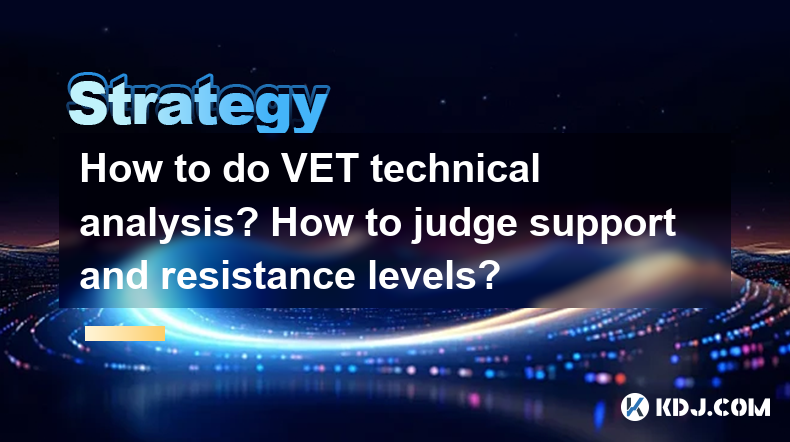-
 bitcoin
bitcoin $110918.433029 USD
-1.69% -
 ethereum
ethereum $3996.872473 USD
-2.43% -
 tether
tether $1.000594 USD
0.00% -
 bnb
bnb $1178.871834 USD
-2.38% -
 xrp
xrp $2.413973 USD
-3.47% -
 solana
solana $194.341461 USD
-4.24% -
 usd-coin
usd-coin $0.999963 USD
-0.03% -
 tron
tron $0.320092 USD
0.92% -
 dogecoin
dogecoin $0.196919 USD
-3.42% -
 cardano
cardano $0.669585 USD
-3.63% -
 hyperliquid
hyperliquid $37.485952 USD
-3.58% -
 ethena-usde
ethena-usde $1.000026 USD
-0.02% -
 chainlink
chainlink $18.018220 USD
-5.13% -
 bitcoin-cash
bitcoin-cash $523.879267 USD
-2.41% -
 stellar
stellar $0.324655 USD
-3.67%
How to do VET technical analysis? How to judge support and resistance levels?
Technical analysis for VET involves studying historical price data, identifying patterns, using indicators like MA, RSI, MACD, and pinpointing support and resistance levels to inform trading strategies.
Apr 30, 2025 at 05:35 am

Technical analysis is a crucial tool for cryptocurrency traders looking to make informed decisions. When it comes to VeChain (VET), understanding how to perform technical analysis and identify support and resistance levels can significantly enhance your trading strategy. This article will guide you through the process of conducting technical analysis on VET and pinpointing key support and resistance levels.
Understanding the Basics of Technical Analysis
Technical analysis involves studying historical price data and market statistics to predict future price movements. For VET, this means analyzing charts and using various indicators to gauge market sentiment and potential price trends. The foundation of technical analysis is the belief that historical price action can provide insights into future market behavior.
To begin your technical analysis of VET, you'll need access to a reliable charting platform. Popular platforms include TradingView, Coinigy, and CryptoWatch. Once you have your charting tool set up, you can start by examining different time frames, such as daily, weekly, or hourly charts, depending on your trading style.
Identifying Key Price Patterns
One of the first steps in technical analysis is to identify key price patterns that can signal potential trend continuations or reversals. For VET, common patterns to look for include:
- Head and Shoulders: This pattern can indicate a reversal in the current trend. It consists of three peaks, with the middle peak (the head) being the highest and the two outer peaks (the shoulders) being lower.
- Double Tops and Bottoms: These patterns suggest a potential reversal. A double top forms after an uptrend and signals a bearish reversal, while a double bottom forms after a downtrend and signals a bullish reversal.
- Triangles: Triangles can be ascending, descending, or symmetrical and often indicate a continuation of the current trend. They are formed by converging trendlines and can signal a breakout once the price moves outside the triangle.
By recognizing these patterns on VET's price chart, you can better anticipate potential price movements and adjust your trading strategy accordingly.
Using Technical Indicators
Technical indicators are mathematical calculations based on historical price, volume, or open interest data. They can help you identify trends, momentum, and potential reversal points. For VET, some of the most useful technical indicators include:
- Moving Averages (MA): Moving averages smooth out price data to identify trends over time. The Simple Moving Average (SMA) and Exponential Moving Average (EMA) are commonly used. A crossover of short-term and long-term MAs can signal a potential trend change.
- Relative Strength Index (RSI): The RSI measures the speed and change of price movements. It ranges from 0 to 100 and is typically used to identify overbought or oversold conditions. An RSI above 70 may indicate that VET is overbought, while an RSI below 30 may suggest it is oversold.
- Moving Average Convergence Divergence (MACD): The MACD is a trend-following momentum indicator that shows the relationship between two moving averages of VET's price. It can help identify potential buy and sell signals.
To use these indicators effectively, add them to your VET chart and observe how they interact with the price action. Adjust the settings of each indicator to suit your trading style and timeframe.
Determining Support and Resistance Levels
Support and resistance levels are crucial for understanding where VET's price may find a floor or ceiling. Support is a price level where a downtrend can be expected to pause due to a concentration of demand, while resistance is a price level where an uptrend can be expected to pause due to a concentration of supply.
To identify support and resistance levels for VET, follow these steps:
- Analyze Historical Price Data: Look at past price charts to identify levels where VET has consistently found support or resistance. These levels are often significant because they represent areas where traders have previously placed buy or sell orders.
- Use Trendlines: Draw trendlines to connect consecutive lows or highs on the VET chart. These trendlines can help you visualize potential support and resistance levels.
- Observe Volume: High trading volume at specific price levels can indicate strong support or resistance. Look for areas where the volume spikes as VET approaches these levels.
- Utilize Technical Indicators: Some indicators, like the Fibonacci retracement tool, can help you identify potential support and resistance levels. Draw Fibonacci retracement levels between significant highs and lows on the VET chart to find key levels.
Once you've identified these levels, monitor how VET's price interacts with them. A break above resistance or below support can signal a potential trend change.
Applying Technical Analysis to VET Trading
Now that you have a solid understanding of how to perform technical analysis and identify support and resistance levels for VET, it's time to apply this knowledge to your trading strategy. Here's how you can incorporate these insights:
- Set Entry and Exit Points: Use your identified support and resistance levels to set entry and exit points for your VET trades. For example, you might enter a long position near a strong support level and exit near a resistance level.
- Use Stop-Loss Orders: Place stop-loss orders just below support levels to limit potential losses if the price breaks down. Similarly, place take-profit orders near resistance levels to secure profits if the price reaches your target.
- Combine Multiple Indicators: Don't rely on a single indicator or pattern. Instead, use a combination of technical indicators and price patterns to confirm your trading signals. For example, if the RSI indicates an overbought condition and the price is approaching a resistance level, it may be a good time to consider selling.
By integrating these technical analysis techniques into your VET trading strategy, you can make more informed decisions and potentially improve your trading outcomes.
Frequently Asked Questions
Q: Can technical analysis be used for long-term VET investing?A: Yes, technical analysis can be applied to long-term investing in VET. While it is commonly used for short-term trading, long-term investors can use technical analysis to identify key support and resistance levels over extended periods, helping them make informed decisions about when to enter or exit their positions.
Q: How often should I update my technical analysis for VET?A: The frequency of updating your technical analysis for VET depends on your trading style. Short-term traders may need to update their analysis daily or even hourly, while long-term investors might review their analysis weekly or monthly. It's essential to stay current with market conditions and adjust your analysis as new data becomes available.
Q: Are there any risks associated with relying solely on technical analysis for VET trading?A: Yes, there are risks associated with relying solely on technical analysis. Technical analysis does not account for fundamental factors that can influence VET's price, such as project developments or broader market sentiment. It's important to use technical analysis as one part of a comprehensive trading strategy that also considers fundamental analysis and market news.
Q: Can I use the same technical analysis techniques for other cryptocurrencies?A: Yes, the technical analysis techniques discussed for VET can be applied to other cryptocurrencies. However, each cryptocurrency may have unique characteristics and market dynamics, so it's essential to adapt your analysis to the specific asset you are trading.
Disclaimer:info@kdj.com
The information provided is not trading advice. kdj.com does not assume any responsibility for any investments made based on the information provided in this article. Cryptocurrencies are highly volatile and it is highly recommended that you invest with caution after thorough research!
If you believe that the content used on this website infringes your copyright, please contact us immediately (info@kdj.com) and we will delete it promptly.
- Coinbase, BNB Token, and Fee Disputes: A New York Minute on Crypto's Latest Drama
- 2025-10-16 16:25:13
- B2B Payments Revolution: How API Integration and Virtual Cards are Changing the Game
- 2025-10-16 16:25:13
- Ethereum, Dogecoin, and the Market Rebound: What's the Hype?
- 2025-10-16 17:05:14
- Paxos, PYUSD, and Ethereum: A $300 Trillion Typo Heard 'Round the Crypto World
- 2025-10-16 16:45:12
- Pi Network, GCV, and Web3: Building a New Digital Reality
- 2025-10-16 16:45:12
- Bitcoin Rally: ETF Investors and Stephen Miran's Rate Cut Predictions
- 2025-10-16 16:50:01
Related knowledge

Practical parameter settings for a Bitcoin multi-timeframe moving average system
Sep 18,2025 at 10:54pm
Optimizing Timeframe Combinations for Bitcoin Trading1. Selecting appropriate timeframes is crucial when building a multi-timeframe moving average sys...

How can I filter out false breakouts in Dogecoin high-frequency trading?
Sep 22,2025 at 01:00am
Understanding False Breakouts in Dogecoin Trading1. A false breakout occurs when Dogecoin's price appears to move beyond a defined support or resistan...

Techniques for identifying tops and bottoms in the Bitcoin on-chain NVT model
Sep 20,2025 at 07:54pm
Understanding the NVT Model in Bitcoin Analysis1. The Network Value to Transactions (NVT) ratio is often described as the 'P/E ratio' of the cryptocur...

What does the surge in open interest in Bitcoincoin futures mean?
Sep 20,2025 at 11:18pm
Understanding the Surge in Dogecoin Futures Open Interest1. A surge in open interest within Dogecoin futures indicates a growing number of active cont...

How can I use the Ethereum USDT premium to gauge market sentiment?
Sep 18,2025 at 11:55pm
Understanding the Ethereum USDT Premium1. The Ethereum USDT premium refers to the price difference between USDT (Tether) traded on Ethereum-based plat...

What should I do if Ethereum staking yields decline?
Sep 20,2025 at 06:18am
Understanding the Causes Behind Declining Ethereum Staking Yields1. The Ethereum network transitioned to a proof-of-stake consensus mechanism with the...

Practical parameter settings for a Bitcoin multi-timeframe moving average system
Sep 18,2025 at 10:54pm
Optimizing Timeframe Combinations for Bitcoin Trading1. Selecting appropriate timeframes is crucial when building a multi-timeframe moving average sys...

How can I filter out false breakouts in Dogecoin high-frequency trading?
Sep 22,2025 at 01:00am
Understanding False Breakouts in Dogecoin Trading1. A false breakout occurs when Dogecoin's price appears to move beyond a defined support or resistan...

Techniques for identifying tops and bottoms in the Bitcoin on-chain NVT model
Sep 20,2025 at 07:54pm
Understanding the NVT Model in Bitcoin Analysis1. The Network Value to Transactions (NVT) ratio is often described as the 'P/E ratio' of the cryptocur...

What does the surge in open interest in Bitcoincoin futures mean?
Sep 20,2025 at 11:18pm
Understanding the Surge in Dogecoin Futures Open Interest1. A surge in open interest within Dogecoin futures indicates a growing number of active cont...

How can I use the Ethereum USDT premium to gauge market sentiment?
Sep 18,2025 at 11:55pm
Understanding the Ethereum USDT Premium1. The Ethereum USDT premium refers to the price difference between USDT (Tether) traded on Ethereum-based plat...

What should I do if Ethereum staking yields decline?
Sep 20,2025 at 06:18am
Understanding the Causes Behind Declining Ethereum Staking Yields1. The Ethereum network transitioned to a proof-of-stake consensus mechanism with the...
See all articles


























![Web3 Crypto Market Morning Report: The market is in decline, altcoins have fallen by more than 5%, Binance compensation has been received, and Memes on the Bnb chain have collectively plummeted [Vic TALK Issue 1444] Web3 Crypto Market Morning Report: The market is in decline, altcoins have fallen by more than 5%, Binance compensation has been received, and Memes on the Bnb chain have collectively plummeted [Vic TALK Issue 1444]](/uploads/2025/10/16/cryptocurrencies-news/videos/web-crypto-market-morning-report-market-decline-altcoins-fallen-binance-compensation-received-memes-bnb-chain-collectively-plummeted-vic-talk-issue/68f043c9c8b44_image_500_375.webp)















































